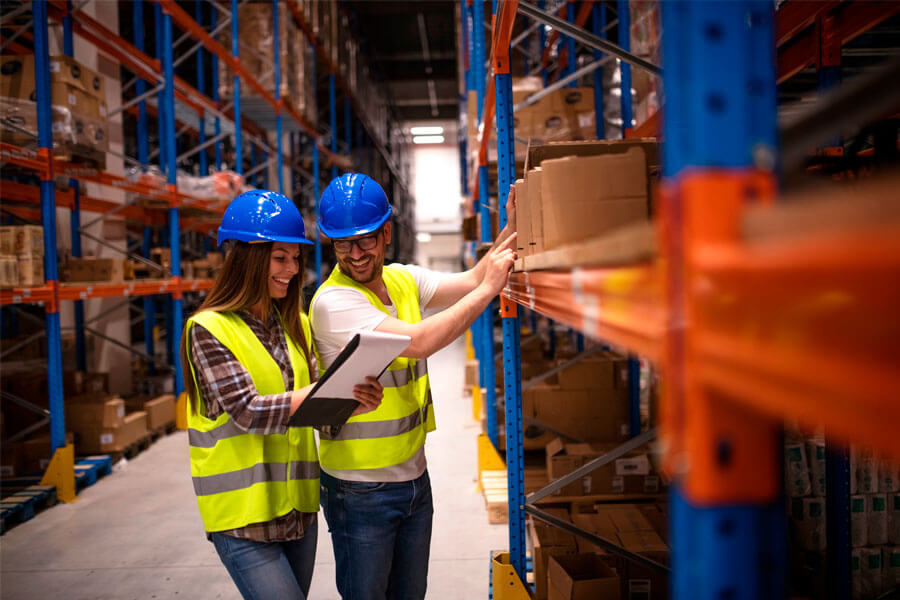Working in a warehouse is not the most dangerous occupation in America. It’s the 34th most dangerous. Here are some warehouse safety tips to help keep workers healthy and the workplace safe.
According to 2020 data compiled by the Bureau of Labor Statistics, the most dangerous jobs in America are in the fishing and hunting industry (after all, the show is called “The Deadliest Catch” for a reason), with 132.1 fatalities per 100,000 workers. “Hand laborers and freight, stock and material movers” landed 34th on the list with five fatalities per 100,000 workers. However, the list does not take into account the hundreds of thousands of injuries to warehouse workers that occur every year (213,100 warehouse-related injuries occurred in 2020).
While any inclusion on a list of the “most dangerous occupations in America” is not great, it does not actually mean that a warehouse is a dangerous work environment. It means that a warehouse CAN be a dangerous work environment. As a warehouse manager, it is your responsibility to ensure that the workplace is as safe as possible, that every worker follows the proper safety procedures and that your company’s warehouse safety message is clear, coherent and consistent.
Safety points in warehouse operations
Material handling equipment
Heavy material handling equipment, like forklifts, are some of the most valuable tools in a warehouse. Forklifts can also be among the most hazardous types of equipment to both operators and pedestrians when people do not follow general warehouse safety tips. Careless handling, inattentiveness and accidental entanglement (generally due to loose clothing) can all lead to severe accidents and injuries.
Trips, slips and falls
Navigating a warehouse floor can be tricky. Whether it is due to spilled liquid, an errant box, an unsecured cord or debris accidentally brought in from outside, a tumble can range from a minor sprain to a major injury.
Manual Handling
Nearly half of all warehouse-related injuries occur due to lifting a heavy object. Improper form or straining to lift too much weight can cause lasting back and shoulder injuries.
Falling objects
If inventory is improperly secured on high racks or carelessly stacked on top of one another, it can lead to a dangerous, even potentially fatal, event.
Fire
Improperly ventilated areas, damaged wires and poorly labeled evacuation routes are serious warehouse hazards.
Safety tips for warehouse workers
Create a personal protective equipment policy—and supply the equipment
Personal protective equipment (PPE) is clothing and accessories that help lower the risk of workplace injuries. There is no universal PPE policy because requirements vary according to the needs of the workplace. According to Occupational Safety and Health Administration (OSHA) guidelines, “If PPE is to be used, a PPE program should be implemented.”
Some possible inclusions for a PPE policy are:
- Protective eyewear for employees who work with potentially dangerous chemicals or machinery that generates projectiles or sparks.
- Back supports and gloves for employees who regularly lift heavy or dangerous items.
- Earplugs or muffs to minimize hearing loss due to a noisy work environment.
- High-visibility vests, hardhats and other clothing with reflective tape to help employees stand out from their surroundings, so they are easier to spot by forklift and machinery operators.
- Heavy work boots or other protective footwear helps workers avoid injury from machinery or falling objects.
- N95 or surgical style masks, depending on the company’s policy toward reducing the risk of contagious disease.
Inspect material handling equipment daily
OSHA requires forklift operators to perform daily inspections of their forklifts. Creating a forklift checklist enables operators to ensure they don’t miss any crucial details and still go through each step quickly. A checklist makes the inspection process as efficient as possible while leaving little room for error.
A few suggestions for a forklift checklist include:
- Examine and record brake, engine oil, transmission and radiator fluid levels.
- Check the battery’s charge and water level and ensure it is free from corrosion, leaks and cracks.
- Test the tires’ condition and pressure.
- Visually check the lift system (never check chains, cables and forks by hand).
- Test the seat belt.
Set up first aid and fire prevention stations
Every area of a warehouse should have easy access to:
- First-aid kits.
- Hazardous waste spill kits (where appropriate).
- Emergency medical stations with showers and eye-rinsing equipment.
A large operation should have several first-aid kits to help workers patch up everything from minor scrapes and cuts to burns and severe wounds. OSHA has established regulations regarding the minimum requirements for first-aid kit supplies:
- Gauze pads (at least 4 x 4 inches).
- Two large gauze pads (at least 8 x 10 inches).
- One box of adhesive bandages (band-aids).
- One package of gauze roller bandage, at least two inches wide.
- Two triangular bandages.
- Wound cleaning agent, such as sealed moistened towelettes.
- Scissors.
- At least one blanket.
- Tweezers.
- Adhesive tape.
- Latex gloves.
- Resuscitation equipment, such as a resuscitation bag.
- Two elastic wraps.
- Splint.
- Directions for requesting emergency assistance.
Proper signage
Just as yield and stops signs help keep drivers and pedestrians safe, proper signage helps employees and visitors safely navigate a warehouse facility. For example, signage that clearly separates pedestrian and equipment lanes and specific warehouse areas can help streamline the flow of products and people while improving warehouse safety. Also, you should use signage to note all potential hazards, the correct PPE for the area, and what to do if an accident occurs.
Warehouse safety tips 2022
Warehouse safety do’s and don’ts largely remain the same from year to year. However, it can be easy for workers to become overconfident. Hanging a daily warehouse safety tips sign in a visible location or consistently closing a daily briefing with some warehouse safety tips of the day can help reinforce these warehouse safety ideas for your employees. Texas Motive Solutions understands the importance of warehouse safety—especially regarding forklift batteries and related accessories. For more safety tips and all your forklift batteries and accessories needs, please call our forklift repair service team at (888) 316-2459. You can also fill out this form to learn about our services and discover everything we can do for you.



